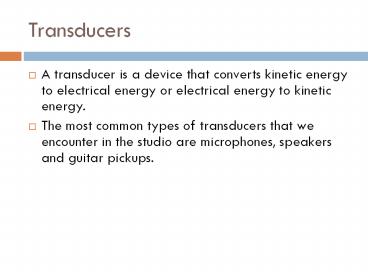Transducers - PowerPoint PPT Presentation
Title:
Transducers
Description:
Transducers A transducer is a device that converts kinetic energy to electrical energy or electrical energy to kinetic energy. The most common types of transducers ... – PowerPoint PPT presentation
Number of Views:236
Avg rating:3.0/5.0
Title: Transducers
1
Transducers
- A transducer is a device that converts kinetic
energy to electrical energy or electrical energy
to kinetic energy. - The most common types of transducers that we
encounter in the studio are microphones, speakers
and guitar pickups.
2
How a Speaker Works
- An electrical signal from a power amplifier flows
through the coil, the resulting magnetic field
interacts with the field of the permanent magnet.
- This causes the coil to move back and forth
according to the variations in the electrical
current. - The flexible speaker cone attached to the coil
moves with it and thus creates fluctuations in
physical air pressure.
A speaker is essentially a dynamic microphone in
reverse
3
Types of Microphones
- Dynamic Microphones
- Relatively Cheap, Sturdy, Reliable
- Examples Shure SM57, SM58 EV RE-20
- OK for sound reinforcement, some recording
- Better for some things e.g., loud electric
guitar - Less sensitive, dont tend to pick up as much
ambient sound - Do not require power for pre-amplification
4
Types of Microphones
- Uses a movable plate called a diaphragm to detect
fluctuations in air pressure - Translates those fluctuations to electrical
current using a voice coil and stationary magnet.
5
Types of Microphones
- Condensor (Capacitor) Microphones
- Expensive, Delicate, Sensitive
- Require power for pre-amplification
- Modern microphones use Phantom Power
- Examples AT 4033 Neumann U87, KM 84
- Usually best for professional recording
- Many types with different characteristics
6
Types of Microphones
- contains a flexible diaphragm as well as a
stationary backplate - The fluctuation of the diaphragm causes a change
in electrical charge between the two plates.
7
Microphone Characteristics
- Basic types
- Omnidirectional (360 degree response)
- Directional (limited response field)
- Cardioid (most common)
- Supercardioid
- Hypercardioid
- Figure 8 (bi-directional)
8
Microphone Polar Patterns
9
Microphone Polar Patterns
10
Frequency Response
- Ideally, a flat frequency response
- No coloration accurate across spectrum
- WYHIWYG (audio equivalent of WYSIWYG)
- Closest to flat response directly in front, at
optimal distance from microphone - Proximity Effect
- Coloration enhanced bass response when close

